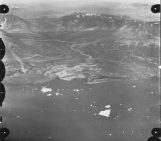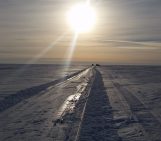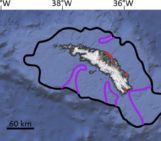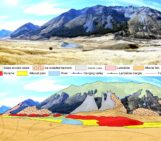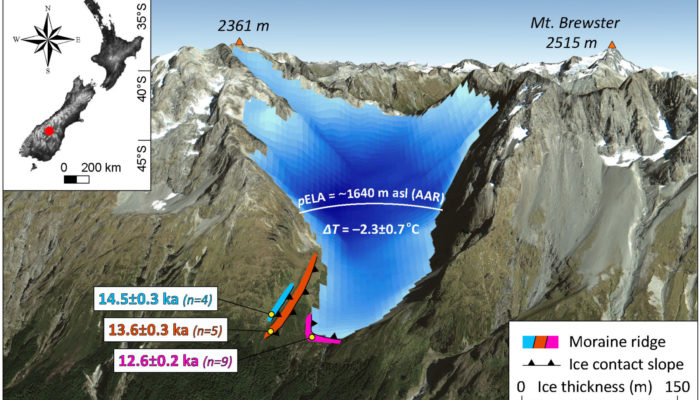
In this week’s blog, Levan Tielidze tells us about the insight into the response of mountain glaciers to the Antarctic Cold Reversal (ACR) event in New Zealand to better understand the climatic history of the Southern Hemisphere during the last deglaciation. The ACR was a cold period occurred in the Southern Hemisphere during the transition from the last glacial period to the current interglacial one. A kind of last glacial gasp during the warming of the southern hemisphere. Let’s discover something more!
When was Antarctic Cold Reversal
After the Last Glacial Maximum (about 21,000 years ago), the last deglaciation began worldwide. This period was characterized by global warming and sea level rise due to the massive discharge of freshwater from continental ice sheets and glaciers. The process of warming and ice melting continued globally almost until the Early Holocene (around 11,700 years). However, the warming trend during the deglaciation was interrupted by cooling episodes between ~15,000–12,000 years ago. They were not synchronous in the two hemispheres. A major cooling events was specifically recognised in the Southern Hemisphere and in mid-latitudes, including New Zealand. It is known as the Antarctic Cold Reversal and occurred between 14,500 and 12,500 years ago. Investigating climate fluctuations during the Antarctic Cold Reversal is important because they provide an example of non-linear climate change during a past period of global warming, which may have relevance for present-day climate change that will become even more acute under the projected warming. Putting such changes into perspective requires a deep understanding of past climate evolution as a possible window for the prediction of future changes of the climate. Glacier records from New Zealand situated in the southwestern Pacific provide a rare record of past Southern Hemisphere climate changes and are ideal tools for testing hypotheses about the competing drivers of the Antarctic Cold Reversal.
The new study
In a recently published study, we aimed to improve our understanding of the glacier behaviour and climate events during the Antarctic Cold Reversal in the Southern Alps of New Zealand. Using cosmogenic exposure dating and geomorphological mapping we reconstructed the geometries of former glaciers in the Ahuriri River valley. Furthermore, based on the reconstructed glacier snowline (i.e. the boundary between the zone of the glacier that accumulates snow and the one subject to ice melting) and the local temperature gradient we estimated past temperatures during the Antarctic Cold Reversal.
Our results indicate that the advance of the former glacier during the cold pulse culminated at ~14,500 years ago, while the next re-advance or stationary phase occurred at ~13,600 years ago (Figure 2). About thousand years later (~12,600 years ago), the former glacier had lowered ~140 m and built another prominent terminal moraine ridge.

Figure 2. Photo of the two clearly visible moraine ridges from the Southern Alps indicating glacier re-advance or stationary phase at ~14,500 and ~13,600 years ago. Yellow dots indicate the location of the samples. Black digits indicate sample ages, while the red numbers indicate sample names. The outlier (excluded) sample is given by red italic text. [Credit: Tielidze et al., 2023].
Further reading
- Kaplan et al. (2013) “The anatomy of long-term warming since 15 ka in New Zealand based on net glacier snowline rise” Geology 41:887-890.
- Putnam et al. (2010) “Glacier advance in southern middle-latitudes during the Antarctic Cold Reversal” Nature Geoscience 3:700-704.
- Tielidze et al. (2023) “Early glacier advance in New Zealand during the Antarctic Cold Reversal” Journal of Quaternary Science.
Edited by Stefan Thiele & Giovanni Baccolo
 Levan Tielidze is an early career scientist at Victoria University of Wellington, New Zealand and at Ilia State University, Georgia. His field of research is modern glaciers and glacial-geomorphological studies of the mountainous areas in the Late Quaternary. Contact email: tielidzelevan@gmail.com. He tweets as @LevanTielidze.
Levan Tielidze is an early career scientist at Victoria University of Wellington, New Zealand and at Ilia State University, Georgia. His field of research is modern glaciers and glacial-geomorphological studies of the mountainous areas in the Late Quaternary. Contact email: tielidzelevan@gmail.com. He tweets as @LevanTielidze.

